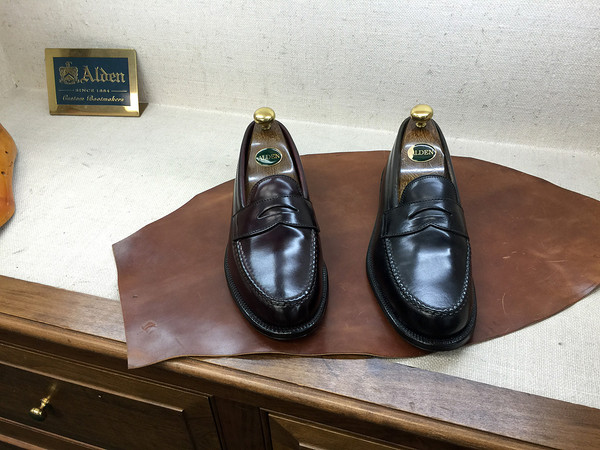A Basic Guide to Cordovan Shoes
Apr 24th 2018
It may come as no surprise that a nice pair of dress shoes can quickly become expensive. Therefore, you have to be smart about your decision, so you can select a pair of shoes that will last you for years. In recent years, Shell Cordovan shoes have risen in popularity. However, many are still unfamiliar with this type of dress shoe. To help understand more about this kind of shoe here is a fundamental guide to this stylish footwear option.
What Do You Look for When Purchasing Shoes?
It doesn’t matter what type of dress shoe you are purchasing; you should always look at the quality of the footwear. You can tell a good deal about the construction of a shoe by watching for a few key characteristics:
• Choose a shoe made from real leather (including leather soles and a high-quality lining).
• Check the soles. A good quality shoe will not have a glued sole. Instead the sole will attach to the bottom with quality stitching, ideally Goodyear welting.
• Assess the stitching on the rest of the shoe. The stitching on the footwear should be barely noticeable and neat throughout the shoe.
What Are Cordovan Shoes?
Shell Cordovan shoes are a type of dress shoe made out of horsehide. To make this kind of shoe leather, tanners take a portion of muscle located at the rump of the horse. This portion of leather is poreless and tough, making it hold shape well. The leather for cordovan shoes is treated using the vegetable tanning process. During this, oil will slowly seep into the leather over a period of time (generally sometime between six and nine months). As the oil seeps in, the cordovan leather becomes highly impermeable, making for a water-resistant, comfortable shoe.
Why Are Cordovan Shoes More Expensive?
The area of muscle from the horse provides roughly two large ovals of leather. Each leather oval will make approximately one to one-and-a-half shoes. Therefore, one horse will create about one complete pair of shoes. The tanning process also takes a minimum of 6 months. Understandably, at this rate of production, it can become very expensive for tanners to produce Cordovan leather.
What Is the Difference Between Cordovan Leather and Box-Calf?
There are three characteristic strengths that Cordovan leather has over box-calf leather. These characteristics are as follows:
1. Cordovan possesses a natural shine, even without additional products.
2. Cordovan is more durable.
3. Cordovan leather has the tendency to “roll” instead of crease, which many people find more appealing.
What Items Do You Need to Care for Cordovans?
Like many other dress shoes, Cordovans require proper care in order to last for the maximum amount of time. However, before going through the necessary steps to ensure your footwear remains in the best shape possible, make sure you have all of the items needed for said care. The best accessories to have on hand are:
• Cotton Cloth
• Deer Bone
• Shoe Tree
• Horsehair Brush
• Shoe Cream
• Paste Wax
What Are the Steps for Proper Shoe Care?
There are a variety of ways for caring for your shoes, but each method has the same goal. When performed regularly, proper shoe care can help to fix a number of issues and keep your footwear looking the best they possibly can.
Regular Maintenance
Shell Cordovan does not need to be polished often. we recommend polishing Cordovan once every 1-2 months, depending on how often you wear your shoes. Routine maintenance and regular brushing will go a long way. You can use the below procedure to maintain your shoes.
1. Place the shoe on a shoe tree and remove the laces.
2. Buff off any dust.
3. Wipe the shoe with a damp cloth. Whenever the shoe is a little more dirty than usual, it is always a good idea to wipe them with a damp cloth; however, make sure you squeeze out the majority of the water first. Using a good deal of pressure, wipe around the entire shoe, including both the heel edges and the sole.
4. Using the horsehair brush, lightly and quickly brush over the whole shoe. Then brush any areas with creases. Remember, even just using a horsehair brush can dramatically refresh your shoes by bringing back the shine and removing minor stains and marks.
Deer Bone
Some customers like to use a deer bone on their Cordovan shoes to help reduce scuffs or “rolls”. Deer bones should be infused with natural oils for lubrication. Store your deer bone in a plastic bag to prevent drying. Do not use dried-out deer bones on your shoes.
1. Insert shoe trees into your shoes.
2. After a quick buff, rub the shoes with the smoothest part of the deer bone with an applied circular pressure. Hold the deer bone horizontally with your hands at either end. Special care should be given to avoid scratching leather.
3. After using the deer bone, lightly brush any rough areas and use a cotton cloth to buff the shoe to a shine. Then, apply polish normally.
Polishing
Cordovan is already layered with fats and oils, so it does not need as much polishing as other leathers. You will want to polish your shoes about once every month or so. Apply waxes very sparingly with a clean cotton tee shirt or Alden Polishing Cloth. A build-up of excess polish attracts dust, is easily scratched, and hides the natural luster of the leather. Start lightly, as you can always add another layer of polish if necessary.
Alden does not recommend using their boot creams on Shell Cordovan. Our experts at TheShoeMart use these products with Shell Cordovan when it needs additional moisture, however, we wouldn’t recommend this technique to beginners.
For more information about Cordovan shoes, contact the professional shoe enthusiasts at TheShoeMart by calling 203-853-6543 today.

